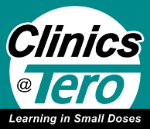Discover Tero Hiring Clinics

Recruiting: This 90-minute interactive session will create an awareness of methods and strategies for effective recruiting. Participants discover that recruiting activities are ongoing, even if a specific job isn't being filled. Beyond seeking candidates who are qualified for the job, the importance of cultural fit and motivational fit are examined. Innovative methods of attracting diverse candidates will be explored through engaging discussion and group activities.
Key Takeaways:
- • Traditional and non-traditional recruiting approaches
- • Recruiting for cultural fit

What Goes Wrong: This 90-minute interactive session will create an awareness for what goes wrong in the hiring process. Through a process of self-discovery and examination of research, participants learn to pinpoint the parts of the selection system that lead to problems. Lack of consistent process, ineffective recruiting methods, unskilled interviewers, overlooking cultural fit and interpersonal skills, interviewer biases, lack of preparation, lack of candidate availability, stress or deadlines that lead to poor decision-making and leaving candidates with a poor impression of the organization are among the barriers examined. Post-hiring challenges are also highlighted.
- Why employee selection systems fail
- Actionable steps to overcome barriers to achieving hiring goals

Screening : Screening interviews in the selection process serve many purposes. They are the first step to getting to know the individual, the first step for the candidate to form an impression of the organization and the first step in critical data collection to identify the best matched candidate for the job. As an early step, there are also potential missteps that negatively affect later steps in the process. In this 90-minute interactive session, leaders discover how to conduct consistent, efficient and reliable screening interviews that leave a good impression on applicants.
Key Takeaways:
- • Questions to ask in a screening interview
- • Determine whether to advance a candidate to the next step

Cultural Fit: Leaders already know that it's not enough to find a qualified candidate for the job. Care must be taken to ensure the individual also fits the organization's unique culture. In this 90-minute interactive session, through examining best practices and participating in individual and group activities, leaders learn how to analyze organizational culture and how to hire for cultural fit while also seeking a diverse workforce.
Key Takeaways:
- Cultural fit analysis
- The difference between sameness and diversity

Motivational Fit: We've all seen examples of motivated people who outperform individuals with greater qualifications or skills. How can you determine if a person is motivated to do the job or if they are motivated to get the job? In this 90-minute interactive session, leaders acquire knowledge and tools to ascertain if the things that are inherent in the job are also the things that interest and motivate each candidate.
Key Takeaways:
- • Motivational fit grid
- • Behavioral-based approach to evaluating motivational fit

Job Fit: In this 90-minute interactive session, leaders clarify what skills, knowledge and abilities are essential for job success. This sets the stage for how interviews will be conducted. Beyond technical skills, most jobs require competency in interpersonal and personal skills such as problem-solving, initiative, teamwork, leadership and integrity. Through guided discussion and breakout sessions, leaders learn how to use a competency model for job analysis and create interview questions.
Key Takeaways:
- Competency model for job analysis
- Questions to ask around each competency

Behavioral-Based Interviews: The in-depth interview may be the most important element in the selection process. It serves to not only collect information from each candidate, it provides information to the candidate on the organization and position. During this 90-minutes interactive session, leaders discover why behavioral-based interviews are the best available tool for identifying the best candidate for the job. When well done, they also hold interviewers accountable for personal biases and prevent candidates from exaggeration. A behavioral-based approach to interviewing sounds simple yet considerable skill is needed to differentiate between true examples of behavior and theoretical statements and opinions.
Key Takeaways:
- • Formula for conducting behavioral-based interviews
- • Tips for controlling the direction and pace of the interview

Orientation: Hiring managers have a critical role in ensuring that the first day, first week, first month and first 90 days for the new hire serve to set the stage for success. New employee orientation is more than facilitating introductions, conducting tours, assigning technology, completing new hire paperwork and participating in compliance training. Whether new to the organization or the result of a promotion or transfer, during this 90-minute interactive session, leaders discover how to imprint their new charge into the team culture, set expectations and provide opportunities for training, feedback and coaching.
Key Takeaways:
- Create a plan for a new hire
- Imprinting techniques

Retention: High employee retention results in less time and resources required for hiring and training. It ensures that opportunities are not lost due to delays in having fully skilled, capable workers in jobs. In this 90-minute interactive session, they also learn to conduct their own internal research that informs how they can create an environment for high employee retention and engagement.
Key Takeaways:
- • Conducting stay interviews
- • Using interview data to improve employee retention and engagement

Promotion: Have you ever seen a top performer struggle after being promoted to a new role? Doesn't it make sense to prepare individuals for new responsibilities before they are promoted? During this 90-minute interactive session, leaders learn how to carry out a needs assessment and gap analysis that sets the stage for creating the development plan essential for preparing someone for promotion to the next job.
Key Takeaways:
- 3 critical components for every job description
- Conducting a needs assessment and gap analysis for an individual

Succession Planning: More and more companies are asking if they have qualified people ready to fill key positions in the short-, medium-, and long-term. Succession planning is a highly specialized form of employee and leader development that ensures future growth and security for the organization. During this 90-minute interactive session, leaders realize that succession planning is more than having a plan to promote individuals within the organization. It is also more than a training initiative. It requires a strategy and intentional, ongoing execution.
Key Takeaways:
- • Difference between a succession plan and a succession pool
- • 6 challenges to succession planning efforts
Sign-up to learn the latest from Tero !
Whether you’re looking for leadership skills or experience on sales, diversity & equity and more , Tero Clinics are available to offer you actionable steps towards developing your professional self.
Sign-Up to be informed about new Tero Clinics that may be going on. You won't want to miss them!

Since 1993, Tero International has earned a distinguished reputation as a premier interpersonal skills research and corporate training company. Professionals from locations around the world are graduates of Tero's workshops and hundreds of leaders turn to Tero for their executive coaching services.
